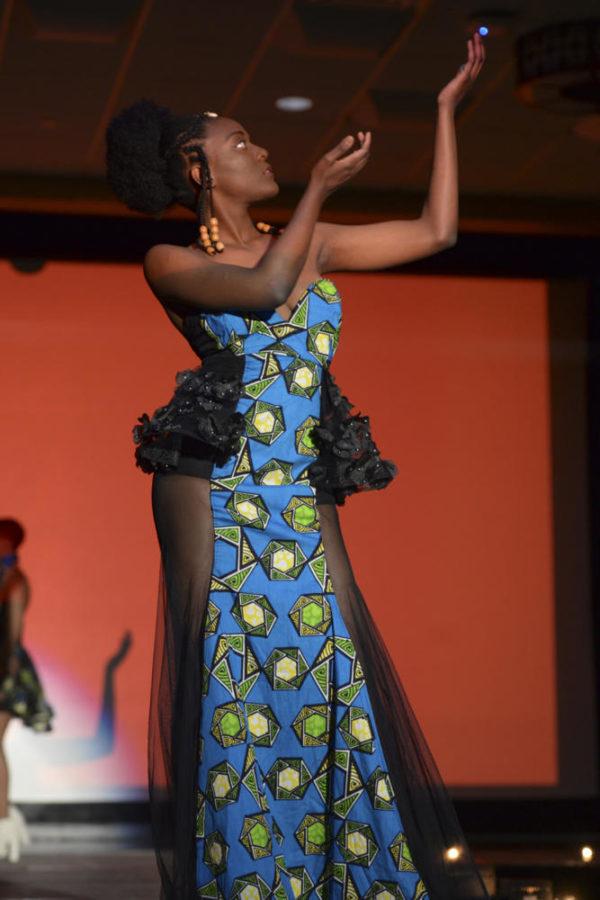A frenzy of applause welcomed models as they sauntered down the white runway.
Red and green lights illuminated the potted trees placed on the back of the stage, while red, yellow, green and purple lights gave the ceiling a rainbow-like appearance. A video showing clips of African children jubilantly dancing in a small village began to play behind them, elevating the energy in the room.
The 11th Annual Wazobia Fashion Show, organized by the African Students Organization, took place March 17 in the William Pitt Union Assembly Room in front of a crowd of about 500. In the three main languages of Nigeria — Hausa, Igbo and Yoruba — Wazobia translates to “come, come, come.”
The collections of five different African designers were brought to life on the runway — including Alaro by Christian Alaro, Kovered Kouture, the Ruba Idris collection, Threaded Culture and Ofuure.
The show’s designers came from all across North America — hailing from places such as Washington, D.C., and Canada — though one collection was designed by Pitt student and ASO event manager Ruba Idris.
Audience members lined all three sides of the catwalk, gazing up at the elegant designs as the models walked the runway. Couples danced or performed a short handshake before passing by each other on the runway. One model opened a collection with a raised fist and the Wakanda forever handshake.
Cold-shoulder tops, crop tops and swing dresses dominated the runway. For the only men’s collection of the night, Threaded Couture, all-black suits paired with red and green colored accents played a large role.
Some notable outfits of the night included a black cold-shoulder top with a shimmering purple dress, a red-checkered long-sleeved shirt and a sleeveless white crop top with a red-and-blue skirt — all featured in the show’s opening.
Dami Olatunde, otherwise known as AphricanApe — a stand-up comic originally from Nigeria — hosted the show, donning an all-orange outfit and black kufi hat before sauntering onto the runway, accompanied by flashing lights and energetic music. During his introduction, Ape performed a quick survey on the racial demographics of the audience.
“To the white people, I see a lot of you guys, thanks for coming on time,” he said. “I feel very successful right now because you know when white people come see you, God is on your case.”
A total of 58 people helped put the event together, including the 33 models who walked in the show. Vashti Webb, a senior triple majoring in communication, health service and Africana studies, lead the fashion show committee.
Webb held three practices a week while communicating with various designers and equipment companies. With all this planning and behind-the-scenes coordination, she actually will not even get to see the show until afterward, when she uploads it to YouTube.
While models got ready between shows, AphricanApe talked about assimilating into American culture as well as his long journey from Nigeria toward obtaining a Visa to enter the United States. He said it took him more than five tries before he finally received one.
AphricanApe also discussed his pride in being African and reflected on a time when many people were not proud to be African.
“I love being African,” he told the crowd, “I wouldn’t trade it for anything.”
A fitting statement to make, as the overarching theme for this year’s fashion show was African pride. Webb said she hadn’t done her job correctly if people weren’t happy with it and didn’t leave with a greater appreciation of African culture.
Senior communication science major Yegene Hong attended the show to support her friends who were modeling for it and who came to photograph the show. Hong said she enjoyed the show’s exciting atmosphere, as well as the humor and charisma of AphricanApe.
“It was energetic and intense,” she said. “The fashion was amazing, and the models did such a good job of representing and rocking each outfit.”
Catherine Crevecoeur, a senior environmental studies major, came to support friends who were modeling for the show.
“It’s held to share cultural things about Africa, it’s always great.” she said. “It helps give African designers exposure too.”
Along with Hong, Crevecoeur said out of all the collections, she especially admired the Ruba Idris collection for its vibrant use of color.
“I enjoyed the use of different prints and the creativity of how the pieces fell on the models. It was different,” Crevecoeur said.
According to Webb, the show does raise some funds to go into next year’s production, as well as toward the upkeep of the club, but its main purpose is to educate audience members on African culture. With the show’s vibrant lighting, comical host and alluring designs, it would be hard to leave without learning something new or feeling satisfied.
“I want people to get that the students in ASO are proud of who they are, I wanted the show to portray a sense of pride from the people,” she said. “I hope that’s what they take away from the show.”



